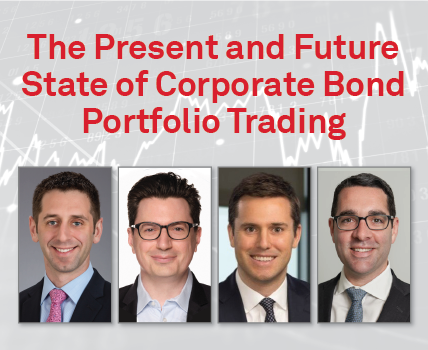Corporate Bond Portfolio Trading Momentum to Continue in 2024
Corporate bond portfolio trading (PT) will continue to grow in 2024 as buy- and sell-side participants increasingly use it to cycle risk and execute trades quickly and efficiently across credit products, according to panelists at a recent Coalition Greenwich webinar, titled “The Present and Future State of Corporate Bond Portfolio Trading.” The webinar was hosted by Kevin McPartland, Head of Market Structure & Technology Research at Coalition Greenwich.
Full Steam Ahead
“2023 represented a significant milestone in portfolio trading in corporate bonds,” said Paris Pender, Head of PT and Macro Credit Trading at Trumid. Trumid analysis saw PT at 8% of all TRACE volume in Q4 as dealers “were very efficient in providing quotes and liquidity, and pricing was reliable.”
At Goldman Sachs, PT currently represents 20% of its institutional corporate bond volumes. “We've seen opportunity across the whole stack of products within credit, including corporate bonds, index products and exchange-traded funds (ETFs). Custom baskets represent another growing part of our business.”
“Portfolio trades are a way to interact with those custom baskets,” said William Wolcott, Partner, Credit Trading, Goldman Sachs. Last year, the investment bank priced 8,000 portfolio trades for more than 300 clients. The average trade size, which has reduced over time, was roughly $60 million with around 100 CUSIPS. It saw both multi-billion-dollar fund flows go through PT in investment grade and had “people using it every day for fund flow management,” where earlier they may have used block trading for $50 million inflows or outflows.
Across-the-Board Adoption
Both buy and sell sides are adopting PT in investment-grade and high-yield credit. At Goldman, it’s an 80:20 mix in favor of investment grade.
Edmund Griffin, Vice President at asset management firm State Street Global Advisors, which trades in high-yield credit, said they weigh factors such as the flow size, notional and ticket count, and their “understanding” of the “difference between the algo and portfolio trading market and institutional market” to determine if PT is suited for a flow.
“There are times when we will have a flow pivoting to bigger sizing, and trading that in the institutional market is a better outcome for our clients with better execution there. And there's also a time when the algo and portfolio trading desks are very aggressive, and trading it in a more diversified basket of bonds is a better outcome,” said Edmund Griffin.
Electronic trading is adding scale and velocity to PT by solving for workflows and straight-through processing. Trumid estimates 80% of PT volumes are electronic. “We have seen increased comfort in doing large trades on platform in comp. And we are also seeing the trend of higher volumes spread out across more trades for smaller notional,” said Paris Pender.
Changing Client Behavior
By allowing investors to put risk to work quickly and efficiently, PT has also “created a growing opportunity set for clients to be tactical within the corporate bond market,” said William Wolcott.
Until three years ago, State Street Global would take a week to invest $250 million to $500 million in high-yield bonds. “We could do probably up to a billion in a day today, depending on the market and price. I think that is changing the asset allocation strategies of our clients,” said Edmund Griffin.
Challenges Amid Growth
As dealer balance sheets in PT grow in terms of gross notional and gross line items, it could pose a potential problem because “that risk ultimately needs to find a home,” said Paris Pender. Unlike in block trade, where dealers and clients are set up to capture bid-offer on buy and sell legs, in PT, “clients initiate portfolio trades, but dealers cannot send them back in the other direction,” he said. “We've made some stabs in recycling the risk from dealers to client. It's an imperfectly solved problem right now.”
Once a dealer executes a PT, there is a tech hurdle in recycling the risk across several dealers too, said Edmund Griffin. “Currently, if the list is 60–70 items long, it's the first person to get to that bond wins. So, it is still archaic on that front.”
Looking Ahead
Both market participants and platforms are expecting the growth momentum to continue. Trumid is developing new portfolio trading analytics, while Goldman expects to see more ETF-related trading. But it is all-to-all PT that offers the next big step forward. That will be the next evolution in PT, although “how that ecosystem works” is still to be decided, said Edmund Griffin.

